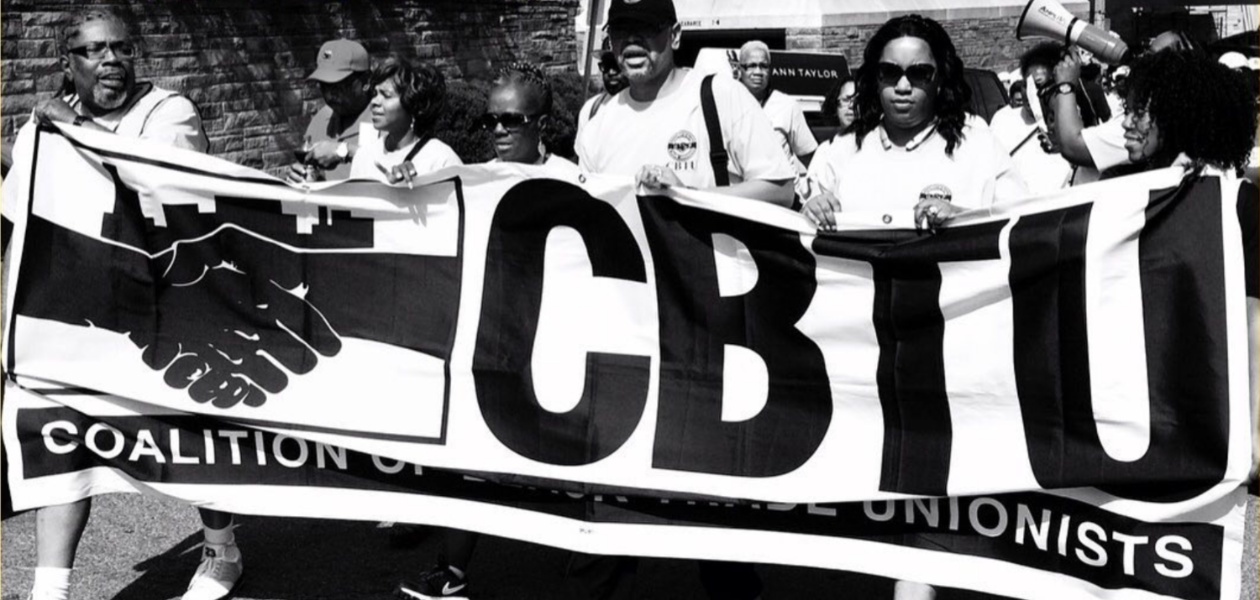
NEW ORLEANS—Facing a crucial election in 2024, delegates to the Coalition of Black Trade Unionists convention are laying plans here for fighting the right, state by state, concurrent with preparing for the national campaign for the presidency next year.
“We will not back down” in “the fight against white privilege,” CBTU President Terry Melvin said in his May 24 keynote address to the crowd of approximately 1,000 delegates and guests (see separate story).
The right, having failed to convince a majority of voters to support its extreme agenda, has retreated to its old tactic, adds Machinists National Legislative and Political Director Hassan Solomon: “If you can’t beat ’em, stop ’em from voting.”
Melvin gave a full-throated endorsement to the re-election of Democratic President Joe Biden and Vice President Kamala Harris—the first African-American woman in one of the nation’s top two jobs. Others discussed how the right-wing anti-voting mantra applies to state legislative battles and voting rights.
It applies not just in swing states like Pennsylvania, Michigan, Wisconsin, and Ohio but in strongly “blue” states with large Black voting blocs, such as Illinois. And it applies in states such as Missouri, where Republican gerrymandering turned a former swing state “red”—except when its voters rejected right-to-work in a referendum several years ago.
The right-wing reaction to that 62% win, which occurred after the legislature’s right-wing supermajority switched the vote away from November to early August in hopes people would be on vacation? They want to make initiatives and referendums harder to put on the ballot, and pass, says Donna Kirts, an Auto Workers retiree from Kansas City.
And defending referendums is just one example of what workers, including workers of color, must fight. Gerrymandered maps is another. Missouri used to have an evenly split state congressional delegation, but now it’s 6-2 Republican. So did Arkansas, now 4-0 GOP.
So did Tennessee, where Democratic Nashville’s majority people-of-color electorate was split between three Republican-dominated districts. The nine-member delegation now has one Democrat, Steve Cohen of majority-Black Memphis. Black voters are also packed together in one district and then split between others, in Alabama. With 27% of the population, they should have two of its seven lawmakers. Georgia is similar.
Brought in Medicare expansion
“Initiatives brought in Medicare expansion” during the pandemic, and the RTW defeat years before that, Kirts elaborated. To suppress referendums, which drew progressives, workers, and voters of color to the polls, rightist state lawmakers want to suppress turnout by raising the signature requirement from its current 180,000 statewide to more than 300,000.
Even if signature–gatherers meet that, a referendum would still need a 60% supermajority to pass. That meant RTW repeal would win and everything else, which got between 50%+1 and 60%, would not.
The rightists’ contempt for voters shows through in that idea, Kirts adds. “They say, ‘The people clearly don’t know what they’re doing.’”
But delegates interviewed admit there’s a problem with that strategy and it affects not just battling right-wing efforts to restrict and depress the vote: It’s reactive.
The right sets the agenda, leaving workers and their allies to play catchup and try to defeat their schemes after the momentum begins.
“When we let the talk shows and the TV shows set the leadership and the messaging, even a lot of our own union members” vote against their own interests, added 59-year UAW member Lew Moye, a St. Louis leader. One answer, he says, is year-round communication and education about the importance of local elections on issues that affect people day-to-day.
“We have to find a better way to communicate: Radio, TV, social media with our own members, many of whom have supported elected senators and representatives, to the detriment of Black and brown people.
“Our labor movement has lost track with our own members.”
Edison Frazier, the Machinists’ chief of staff, offered another idea for stopping the right: Mass community mobilization by reaching out to natural allies. Though he put it in the context of the three unions now jointly organizing at Delta Airlines—IAM, the Teamsters, and the Association of Flight Attendants—it applies to politics, too.
“Through community involvement, we can reach many, many allies,” he explained. “When our community leaders come out, our politicians come out. It makes a difference.”
In an interview with People’s World after moderating the Delta organizing panel, IAM’s Solomon said one way to stop the right is to fight its repressive schemes, both political repression and anti-worker legislation, at the earliest stage possible, such as in legislative committees.
“It’s easier to stop something in a committee of 20 than in a (U.S.) House of 435,” he said.
Expand bottom of ballot operations
Another is to expand unions’ political operation below the presidency, Congress, and even governorships. “At state legislatures, city councils, and even school boards nationwide, we are trying to expand voting rights,” Solomon said. “That means weekend voting, early voting, and that voting day should be a federal holiday.
“After all, we have airline workers on the day’s first, second, and third shifts,” round the clock. They can’t take time out to vote from 9 AM to 7 PM, normal voting hours in most states, or spend hours standing in voting lines.
All those ideas and more were in the Democrats’ original wide-ranging voting rights legislation, HR1, introduced in the early days of 2021 in the then-Democratic-run House. It passed there, on a virtual party-line vote—and fell victim to a threatened Senate filibuster, augmented by Sens. Kyrsten Sinema, D-Ariz., and Joe Manchin, W-W. Va., in the then-evenly split Senate.

Though he has the same targets for state and local elections, Teachers (AFT) Secretary-Treasurer Fedric Ingram, who is also a top African-American unionist, had a different reason for building from the bottom up, he said in a prior exclusive interview with People’s World.
The Democratic Party is so gerrymandered and decimated out of office in the Sunshine State that rabidly right-wing GOP Gov. Ron DeSantis—whom Melvin, a preacher, nicknamed “Ron DeSatan”—that it must recover via the grass-roots, starting with inroads at the local levels, then reaching greater density at those levels before trying for higher office.
It could take years, Ingram admitted, but it pays off in the long run. Other unionists have said Michigan’s 2022 pro-union sweep, the first in decades there, proves that. Pro-union Democratic Gov. Gretchen Whitmer’s landslide over a Trumpite helped win pro-worker forces State Senate control for the first time in 40 years, and the state House for the first time in at least a decade.
And the first legislation that the new Michigan majority approved repealed the state’s right-to-work laws.
But Solomon’s comment is a reminder of a major blunder by workers and their allies in the 2010 election cycle. They concentrated on holding Congress, particularly the U.S. Senate, while ignoring the lower-level races—and got clobbered that November. Hundreds of legislative seats were lost, along with many governorships.
The subsequent right-wing Republican governors, led by Wisconsin’s virulent union foe Scott Walker, but also including—later—Michigan’s John Engler and Indiana’s Mitch Daniels, enacted a raft of anti-worker anti-union laws.
Then they cemented their control through excessive, but legal, gerrymandering. And the gerrymandered lawmakers elected in 2020 continued that particular onslaught. That post-2020 lopsided line-drawing, where lawmakers chose their constituents rather than the other way around, is what made the recent Pennsylvania special state House elections so important. The split there overcame the 2020 gerrymander, giving pro-worker forces a one-vote margin.
It also pointed up what can be done to fight the right if you plan far enough ahead, and put the plans into effect. That’s because even when there were Republican governors in Illinois (Bruce Rauner), Maryland (Larry Hogan), and Massachusetts (Charley Baker), those states didn’t follow that anti-worker lead. In them, unionists and their allies elected and kept, pro-worker supermajorities in legislatures, thwarting the three.
We hope you appreciated this article. At People’s World, we believe news and information should be free and accessible to all, but we need your help. Our journalism is free of corporate influence and paywalls because we are totally reader-supported. Only you, our readers and supporters, make this possible. If you enjoy reading People’s World and the stories we bring you, please support our work by donating or becoming a monthly sustainer today. Thank you!












Comments